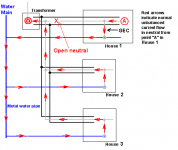Epalmateer
Senior Member
- Location
- Michigan
- Occupation
- Electrician
I used to check for a bad utility neutral by pulling the meter, hooking up a temp with a small air compressor attached to one leg and neutral and checking voltage under load. Now that i can't pull the meter here I can't do that. I was at a job where I suspected a bad utility neutral so I checked voltage under different loads and everything checked out. Later that night one of his surge strips caught fire, and Poco determined it was bad neutral underground. Would the water bond carry neutral load and balance legs, leading me to believe neutral was fine? If I were to turn off the main, disconnect the neutral in the panel, hook up temp on line side of main breaker with a load, and test voltage between that leg and the disconnected neutral, would it have shown an imbalance?


